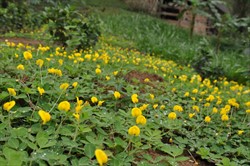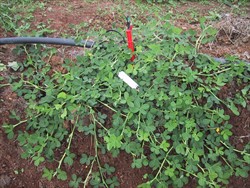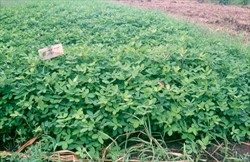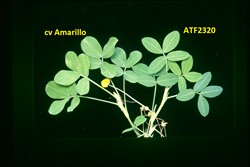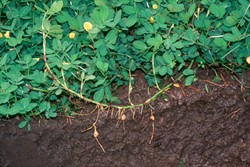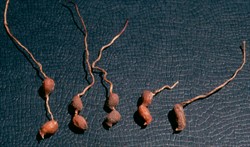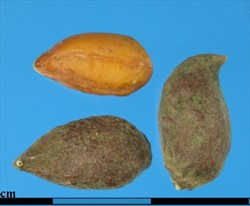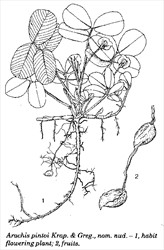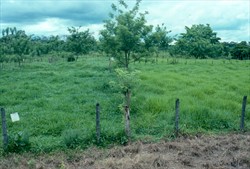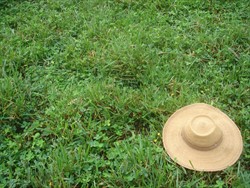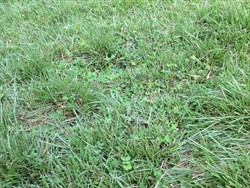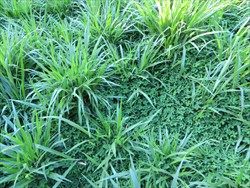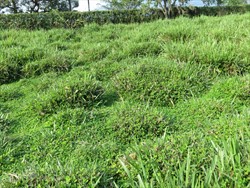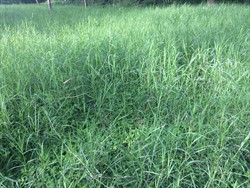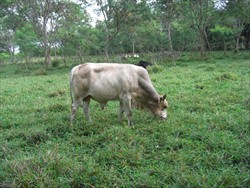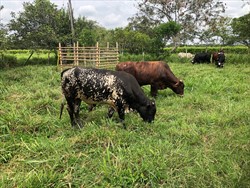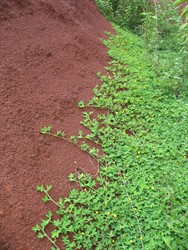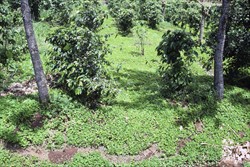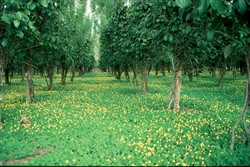Arachis pintoi
Tropical Forages
Arachis pintoi Krapov. & W.C. Greg.
None.
Family: Fabaceae (alt. Leguminosae) subfamily: Faboideae tribe: Dalbergieae section Caulorrhizae.
Stoloniferous, perennial herb developing a strong taproot on the older crowns and forming a dense mat of stolons. Young plants initially erect, with prostrate laterals, rooting at the nodes, and becoming ascendant to 50 cm in height depending on environment and provenance; stems cylindrical, angled when dry, with rigid caducous bristles, distichous. Leaves tetrafoliolate. Stipules adnate to petiole 10‒15 mm from base to pulvinus, × 3 mm wide, with rigid bristles on the back; apical free portion subulate, 10‒12 mm long × 2.5 mm wide at the base, with prominent longitudinal veins, both surfaces glabrous, margin with silky hairs. Petiole up to 6 cm long, canaliculate, with rigid bristles on the back, glabrous canal with fine silky hairs along the margins. Rachis 10‒15 mm long, canaliculate, with a few bristles on the back. Pulvinus pubescent. Leaflets broadly to narrowly ovate or elliptic, with apical pair to 5.0 cm long × 3.5 cm wide and basal pair to 45 mm long × 28 mm wide; glabrous upper surface with scarcely marked margin; lower surface with scattered bristles; margin lightly marked, with silky hairs and some short bristles. Inflorescences very short 4‒5-flowered axillary spikes. Flowers sessile; hypanthium 3.5‒9.5 cm long, with long silky hairs; calyx bilabiate, with silky hairs somewhat more rigid than those of the hypanthium and with bristles; larger lobe 5 mm long, tridentate; upper lobe 6 mm long, narrow, falcate; corolla yellow; standard 12‒17 mm wide; wings 8 mm long; keel 6‒7 mm long, falcate. Fruit biarticulate; peg 5‒32.5 cm long, slightly pubescent toward the base; basal article 11‒13 mm long × 6‒7 mm wide; isthmus 0.5‒8.5 cm long; distal article 12‒14 mm long × 7 mm wide; pericarp smooth, covered with delicate hairs that retain the soil. Abscission layer between seed and peg, causing separation from plant on maturity. Seed size varies markedly with provenance, ranging from over 9,000 seeds/kg in ATF 3270 (GRIF 7499, PI 604813); 7,000 in CIAT 17434; 6,500 in BRA 040550 and 4,000 in ATF 495 (BRA 012122, CIAT 18744).
Similar species
A. pintoi: Leaflets less than two times longer than wide. Bristles present on the stems, stipules, petiole and rachis, frequently also on the underside of the leaflets.
A. repens: Leaflets more than 2.5 times longer than wide. Plants without bristles, except rarely a few on the petiole.
Description based on Krapovickas and Gregory (1994); translated by Williams DE and Simpson CE (2007).
Asia: kacang pinto, kacang hias, kacang-kacangan (Indonesia); mani-manian, mani-mani (Philippines); thua lisong tao (Thailand); cỏ đậu, cỏ lạc (Vietnam)
English: pinto peanut, forage peanut, yellow peanut plant
Europe: arachide de pinto (French)
Latin America: amendoim forrageiro (Brazil); maní forrajero perenne, maní perenne (Spanish)
Native:
South America: Brazil (Bahia, Goiás, Minas Gerais)
Cultivated:
Throughout the wet tropics and subtropics, and upland tropics to c. 1,400 m asl
Forage
Permanent pasture for intensive grazing systems. While most varieties are too low-growing for cut-and-carry, provenances such as cv. Itacambira are taller and more readily harvested. No- or limited-till systems where crops are sown into a A. pintoi sward e.g. autumn oversowing Lolium spp. into a stand of peanut in the humid subtropics - the peanut should be mowed or grazed low prior to sowing. A. pintoi can also be fed to fish and pigs.
Environment
Ideal for bank stabilisation in areas of high rainfall.
Other
Ground cover under orchards, oil palm, and in other systems where shade tolerance is an advantage. Used as ornamental in its native Brazil, and now found in this role throughout the humid tropics.
Soil requirements
Generally found on red, sandy loam river-bottom soils of low to moderate fertility and high aluminium saturation, particularly in low areas, which are wet to flooded during the wet season. In cultivation, A. pintoi has not been restricted by soil texture. Successful on soils with pH (H2 O) ranging from about 4.5 to 7.2, although growth is reduced below pH 5.4. Prefers moderate to high fertility but can survive in infertile soils. Low requirement for copper, molybdenum and lime, and moderate requirement for phosphorus and zinc. Tolerant of high levels of manganese and aluminium. Low to moderate tolerance of salinity.
Moisture
Occurs in areas receiving an annual rainfall from about 1,500 to 2,000 mm. Will survive in areas with annual rainfall of 1,000 mm or less, but grows best with over 1,500 mm/yr. Survives dry seasons of 4 months. Tolerant of periods of waterlogging and of flooding, but does not grow in permanently inundated or waterlogged situations. Irrigation will maintain survival during dry periods but not promote much growth.
Temperature
Originates from about 13‒17º S, and although most collections have been made between 300 and 600 m asl, extremes range from near sea level to about 1,100 m asl. This equates to average annual temperatures of about 21‒23 °C. A. pintoi grows best between about 22 °C (72 °F) and 28 °C (82 °F). Tops are killed by frost, but stands recover from crowns and seedling regeneration.
Light
Generally occurs under low (open) forest native vegetation. Among the most shade tolerant of warm season legumes tested. May produce more growth in shade than in full sunlight.
Reproductive development
Flowers throughout the growing season, although limited by moisture in all situations, and low temperatures or daylength in the subtropics. Flowering apparently stimulated by dry-wet cycle as in A. hypogaea. Seed is produced on pegs (gynophores) developing from extension of the ovary, placing the seed in the soil (geocarpy), mostly in the top 7 cm. Pegs vary in length from 1 to 32 cm. Pegs do not penetrate hard, dry ground and shrivel and die on contact with the soil. In the upland tropics, it normally takes about 6 weeks from flowering to mature pods towards the end of the growing season, although this may be less in mid-season or in the tropics.
Defoliation
Extremely tolerant of low and regular defoliation.
Fire
Rarely subjected to fire by virtue of preferred habitat. However, high levels of soil seed and the capacity to re-establish new crowns at depth if surface crown is destroyed, ensure recovery after fire.
Guidelines for establishment and management of sown forages.
Establishment
Can be established from cuttings or from seed, although plants established from seed develop an effective root system more rapidly. Moderate levels of dormancy in fresh seed can be reduced by pre-drying at 40 ºC for 10‒14 days prior to planting. Once dried, seed should be stored in a cool dry environment - large reductions in viability of inadequately dried and inappropriately stored seed have been experienced within 10 months of harvest. Seed should be inoculated with CIAT 3101 (QA 1091) strain Bradyrhizobium; CIAT 3806 and 2138 also effective.
Seed should be sown at 10‒30 kg/ha seed-in-pod depending on seed quality and price, and the desired early stand density. Should be sown 2‒5 cm deep; surface sowings result in poor germination and high seed losses to birds and rodents. Care should be taken in selection of planting equipment; some mechanisms destroy the soft seed.
Fertilizer
Does not require high levels of fertilizer in most situations. In very infertile soils in Colombia, an establishment application of P 20, Ca 100, K 20, Mg 14 and S 22 kg/ha and maintenance dressings every two years of half this amount have given consistently good results. Appears unresponsive to applied Mo at establishment, due to high Mo reserves in the seed. Applications of Mo may be necessary in 2‒3 year-old stands on very acid soils.
Compatibility (with other species)
Grows well with both sward forming and tussock grasses. Regular defoliation necessary when grown with aggressive grasses to maintain high proportion of legume. Grows well under trees.
Companion species
Grasses: Creeping species such as Axonopus fissifolius, Cynodon dactylon, C. nlemfuensis, Digitaria eriantha, Paspalum maritimum, P. notatum, Urochloa decumbens, U. humidicola; but also forms stable mixtures with bunch grasses such as Megathyrsus maximus and Paspalum atratum where the legume colonises the inter-bunch spaces and grasses are maintained at no more than about 40 cm.
Legumes: Generally not grown in association with other legumes, unless grown under leguminous trees such as Leucaena leucocephala and Calliandra calothyrsus .
Pests and diseases
Diseases cause no long-term or serious damage, but rats and mice are attracted to the nuts and can be a problem. Cv. Amarillo is resistant to the major groundnut diseases, rust (Puccinia arachidis), early leaf-spot (Cercospora arachidicola = Mycosphaerella arachidis) and late leaf-spot (Phaeoisariopsis personata = Cercosporidium personatum = Mycosphaerella berkeleyi). Fungal diseases recorded include various leafspots (Cercospora sp., Phomopsis sp., Periconia sp., Cylindrocladium sp. and Colletotrichum gloeosporioides), the latter also being associated with black stem lesions in Colombia, scab (Sphaceloma arachidis) and foliar blight (Rhizoctonia solani), although none has caused serious damage. The following fungal diseases have been isolated from 'Mandobi', but none has caused serious damage: peanut rust (Puccinia arachidis), anthracnose (Glomerella cingulata; anamorph: Colletotrichum gloeosporioides), Mycosphaerella leaf spot (Mycosphaerella berkeleyi), stem rot and Athelia leaf blight (Athelia rolfsii) and Rhizoctonia leaf blight (Thanathephorus cucumeris). It is advisable not to use pinto peanut as a ground cover in custard apple or atemoya (Annona sp.) orchards because Cylindrocladium, which causes minor damage to the legume, can cause serious damage to the tree leaves. 'Amarillo' has moderate to high resistance to the various root-knot nematodes (Meloidogyne spp.) but is susceptible to the root-lesion nematode (Pratylenchus brachyurus). Other nematodes have been identified in A. pintoi stands in the Amazon region viz. Aphelenchoides sp., Criconemella sp., Ditylenchus sp., Pratylenchus brachyurus, Paratrichodorus minor and Xiphinema sp. Leaves of some plants have an apparently non-pathogenic variegation or chimera that appears similar to the symptoms of mosaic virus. Peanut mottle potyvirus can cause chlorotic ringspots in leaves. Infestations of spider mites (Tetranychus sp.), which can occur, particularly under warm dry conditions, do not cause major damage in the field but can be a problem in the glasshouse.
Ability to spread
Spreads by stolons, up to 2 m/year in the wet tropics and about 1 m/yr in the subtropics. Since seed is set underground, natural dissemination can only be by water erosion. Seeds are soft and digestible and not spread through animals.
Weed potential
Once established, A. pintoi is very difficult to eradicate. It is generally spread by cultivation, and favoured by regular grazing or mowing. Tolerant of many common herbicides. Can be controlled by ceasing defoliation in the presence of taller aggressive species or spraying with metsulfuron methyl. Stands recover quickly by virtue of large, fairly persistent soil seed banks.
Nutritive value
13‒25% crude protein, 60‒70% dry matter digestibility. Relatively low levels of condensed tannins.
Palatability/acceptability
Well eaten by all classes of animals, including chickens, ducks, pigs, rabbits and fish. Selected by cattle if animals exposed to the legume previously.
Toxicity
No record of adverse effects.
Feedipedia link
Dry matter
5 t/ha/yr DM growing with Urochloa humidicola producing 20 t/ha DM, and 10 t/ha growing with U. ruziziensis producing 11 t/ha in Colombia. In subtropical Australia growing in pure stand cut to ground level every 4 weeks produced up to 6.5 t/ha/yr DM. Cumulative yields up to 24 t/ha DM over 2 years have been obtained in Brazil.
Animal production
In Colombia, annual liveweight gains up to 200 kg/head and 920 kg/ha depending on companion grass and dry season stress. In Costa Rica, liveweight gains of cattle grazing A. pintoi in a mixed pasture with Urochloa brizantha of nearly 1,000 kg/ha/yr were recorded. Improvement in liveweight gain and milk production were 20‒200% and 17‒20% respectively, over grass-only.
More details of animal response to A. pintoi feeding are presented in Feedipedia. https://www.feedipedia.org/node/702
Diploid (2n = 20), self-pollinating with low proportion of out-crossing. Has crossed with A. repens (section Caulorrhizae) to produce fertile hybrids, although an assumed spontaneous hybrid between plots of A. pintoi cv. Amarillo and A. repens CPI 28273 in Australia has flowered but not set seed (see "Promising accessions"). A. pintoi × A. paraguariensis ssp. paraguariensis (section Erectoides) hybrids have also proved sterile.
Seed set is geomorphic, mostly in the top 6 cm with a small proportion extending to 12 cm depending on soil characteristics at the site. Seed separates from the peg soon after maturity. Seed is produced throughout much of the growing season, provided moisture is adequate, so harvest is normally undertaken at end of season. The seed crop needs to be kept low during the growing season to encourage seed set and to eliminate haven for rodents attracted to the seed. Most harvesting systems depend on screening of the top 10 cm of soil to obtain seed. Attempts to use conventional peanut harvesting methods that rely on persistent link between seed and peg have resulted in low seed yields. Seed-in-pod yields of over 1 t/ha have been achieved in 'Amarillo', although some provenances are less productive (e.g. CIAT 18750), and some more productive yielding up to 4 t/ha 15 months after sowing. No reduction in "pops" (empty pods) due to applied calcium in Australia. Seed should be dried and stored under low humidity to avoid rapid decline in germinability.
Tolerant of acifluorfen, bentazone, 2,4-D, 2,4-DB, fluazifop-butyl, and sethoxydim. Susceptible to metsulfuron-methyl and glufosinate.
- Tolerant of heavy grazing.
- Tolerant of low fertility, acid soils.
- Productive.
- High quality.
- Good ground cover.
- Combines well with competitive sward grasses.
- Not well suited to cut-and-carry systems.
- Needs good moisture for production.
- Underground seed attracts rodents.
- Difficult to eradicate.
- Slow and costly establishment.
Bowman, A.M., Wilson, G.P.M. and Gogel, B.J. (1998) Evaluation of perennial peanuts (Arachis spp.) as forage on the New South Wales north coast. Tropical Grasslands 32:252–258. bit.ly/3a9fxGK
Cook, B.G. (1992) Arachis pintoi Krap. & Greg., nom. nud. In: Mannetje, L.’t and Jones, R.M. (eds) Plant Resources of South-East Asia No. 4. Forages. Pudoc Scientific Publishers, Wageningen, the Netherlands. p. 48–50. edepot.wur.nl/327785
Ferguson, J.E. and Loch, D.S. (1999) Arachis pintoi in Australia and Latin America. In: Loch, D.S. and Ferguson, J.E. (eds) Forage seed production, Volume 2: Tropical and subtropical species. CABI Publishing, Wallingford, Oxon, UK. p. 427–434.
Gimenes, M.A., Lopes, C.R. and Valls, J.F.M. (2002) Genetic relationships among Arachis species basd on AFLP. Genetics and Molecular Biology 25:349–353. doi.org/10.1590/S1415-47572002000300017
González, M.S., Van Heurck, L.M., Romero, F., Pezo, D.A. and Argel, P.J. (1996) Producción de leche en pasturas de estrella africana (Cynodon nlemfuensis) solo y asociado con Arachis pintoi o Desmodium ovalifolium. Pasturas Tropicales 18:2–12. bit.ly/2J0vwuG
Hernández, M., Argel, P.J., Ibrahim, M.A. and Mannetje, L.’t (1995) Pasture production, diet selection and liveweight gains of cattle grazing Brachiaria brizantha with or without Arachis pintoi at two stocking rates in the Atlantic Zone of Costa Rica. Tropical Grasslands 29:134–141. hdl.handle.net/10568/43927
Jones, R.M. (1997) Persistence of Arachis pintoi cv. Amarillo on three soil types at Samford, south-eastern Queensland. Tropical Grasslands 27:11–15. bit.ly/3a8M2EZ
Kerridge, P.C. and Hardy, B. (eds). (1994) Biology and agronomy of forage Arachis. CIAT Publication No. 240. Centro Internacional de Agricultura Tropical (CIAT), Cali, Colombia. hdl.handle.net/10568/54359
Krapovickas, A. and Gregory W.C. (1994) Taxonomía del género Arachis (Leguminosae). Bonplandia 8:1–186. doi.org/10.30972/bon.81-43559
Krapovickas, A. and Gregory, W.C., transl. by Williams, D.E. and Simpson, C.E. (2007) Taxonomy of the genus Arachis (Leguminosae). Bonplandia 16(Supl.):1–205. doi.org/10.30972/bon.160158
Paganella, M.B. and Valls, J.F.M. (2002) Characterização morfológica de cultivares e acessos selecionados de Arachis pintoi Krapov. & Gregory. Pasturas Tropicales 24:22–29. bit.ly/396S73l
Pizarro, E.A., Ramos, A.K.B. and Carvalho, M.A. (1997) Producción y persistencia de siete accesiones de Arachis pintoi asociadas con Paspalum maritimum en el Cerrado brasileño. Pasturas Tropicales 19:40–44. bit.ly/2UkeYmI
Rincón, A. (2001) Potencial productivo de ecotipos de Arachis pintoi en el Piedemonte de los Llanos Orientales de Colombia. Pasturas Tropicales 23:19–24. bit.ly/2J7Wnow
Valls, J.F.M. and Coradin, L. (2016) Arachis pintoi (Amendoim-forrageiro). In: Vieira, R.F., Camillo, J. and Coradin, L. (eds) Espécies Nativas da Flora Brasileira de Valor Econômico Atual ou Potencial: Plantas para o Futuro ‒ Região Centro-Oeste. Secretaria de Biodiversidade, Ministério do Meio Ambiente, Brasília, DF, Brazil. p. 461‒472. https://bit.ly/2UMZUzo
'Alqueire-1' (BRA 037036) Released in Rio Grande do Sul, Brazil (1998) as a forage for the subtropics of Brazil following work by the Departamento de Plantas Forrageiras da Universidade Federal do Rio Grande do Sul.
'Amarillo' (GK 12787, PI 337361, PI 338314, PI 338447, CPI 58113, CIAT 17434, IRI 2270, IRFL 4222, I 44457) Released in Australia in 1987 Initial provenance, origin Bôca do Córrego, Bahia, Brazil, 26 m asl, 15°51' S (coll. 1954). Mostly prostrate to about 10 cm, ascending to 20 cm. Leaves broad-ovate, mostly pale green, becoming dark green in shade. Used as forage and ground cover.
'Amarillo MG-100' in Brazil (1994) (see ‘Amarillo’)
'Belmonte' (BRA-031828) Released in Brazil (1999) by Estação de Zootecnia do Extremo Sul (ESSUL), Itabela, Bahia, Brazil on the basis of persistence and animal production in southern Bahia where annual rainfall varies from 1,200 to 1,400 mm. More tolerant of dry periods than other lines tested.
'BRS Mandobi' (BRA 040550) Released in Brazil. A variant observed in BRA 031534. Selected in the humid tropics in Rio Branco, Acre (10°01'34" S and 67°42'13" W, 160 m asl, average annual temperature 24.5 °C, RH 80‒90%, average annual rainfall ca. 1,900 mm, wet season from October to April, dry season June to September). Fruit size > cvv. Amarillo and Alqueire-1. High vigor, good leaf:stem ratio and very tolerant of temporary soil waterlogging. Good establishment, reaching more than 90% of ground cover 16 weeks after planting (spacing of 0.5 × 0.5 m). Annual dry matter yields 9‒15 t/ha, with 22.8% av. CP and 65.8% IVDMD. Less drought tolerant than 'Belmonte'. High persistence under grazing in mixed pastures with Cynodon nlemfuensis, Urochloa brizantha and U. humidicola in intensive rotational grazing systems. Adapted to tropical and equatorial regions with rainfall 1,200‒3,500 mm/year.
'Golden Glory' (unknown origin, possibly BRA 012122) Released as an ornamental in Hawaii in 1996. From seed sent to Hawaii from Sarawak, Malaysia, where it was used as ground cover in pepper; originally introduced from Costa Rica. Released by the nursery industry as an ornamental ground cover for use in the open and under trees. Differs from 'Amarillo' in having slightly shorter calyx tube (hypanthium) and smooth undersides of the leaf (cf. hairy in 'Amarillo').
'Itacambira' (W 34b, BRA 031143, CIAT 22160, ATF 2320, IRFL 7133) Released in Brazil origin Francisco Badaro, Minas Gerais, Brazil, 360 m asl, 17°03' S. Greater tendency to ascend than other cultivars, growing to 50 cm without the assistance of other species. Very drought tolerant. Well-developed, deep, woody taproot, with 60 percent of the root-system in the top 30 cm, penetrating to 1.95 m. Greater potential for cut-and-carry than other cultivars.
'Maní Forrajero' (GK 12787 + BRA 012122) Released in Panama in 1997.
'Maní Forrajero Perenne' Released in Colombia 1992 (see ‘Amarillo’)
'Maní Mejorador' in Costa Rica 1994 (see ‘Amarillo’)
'Pico Bonito' in Honduras 1993 (see ‘Amarillo’)
CIAT 18747 (ATF 2717) Tropical America. Rapid establishment and more efficient than other accessions tested in extracting P from rock phosphate when in association with VAM (Vesicular- Arbuscular- Mycorrhiza). Could be more appropriate for degraded soils where native inoculum of VAM may be low.
CIAT 22160 (see cv. Itacambira), CIAT 22172 Tropical America. Less dependent on VAM when rock phosphate was applied and thus could be more appropriate for degraded soils where native inoculum of VAM may be low.
BRA 031143/CIAT 22160, BRA 030449, BRA 031836, BRA 031828, BRA 031844, BRA 031135, BRA 015121/CIAT 18748, BRA 013251/CIAT 17434, BRA 030546, BRA 015598/CIAT 18750 Brazil. Rapid ground cover and early performance in seasonally flooded land with Paspalum atratum BRA-009610 and Urochloa decumbens CIAT 16488.
CIAT 18744, 18748, 18751, and 22160. Humid tropics of Central and South America. Faster establishment and/or higher production than CIAT 17434.
CIAT 18744, CIAT 22268 Selected in Colombia . Broader adaptation than CIAT 17434.
BRA 039187, BRA 039799 and BRA 035033 Selected in Acre, Brazil (2008) Genotypes selected for greater ground cover and aerial biomass production during establishment period.
BRA 039799 and BRA 039187 the most promising options over 3 years at Planaltina; cv. BRS Mandobi declined by year 3.
